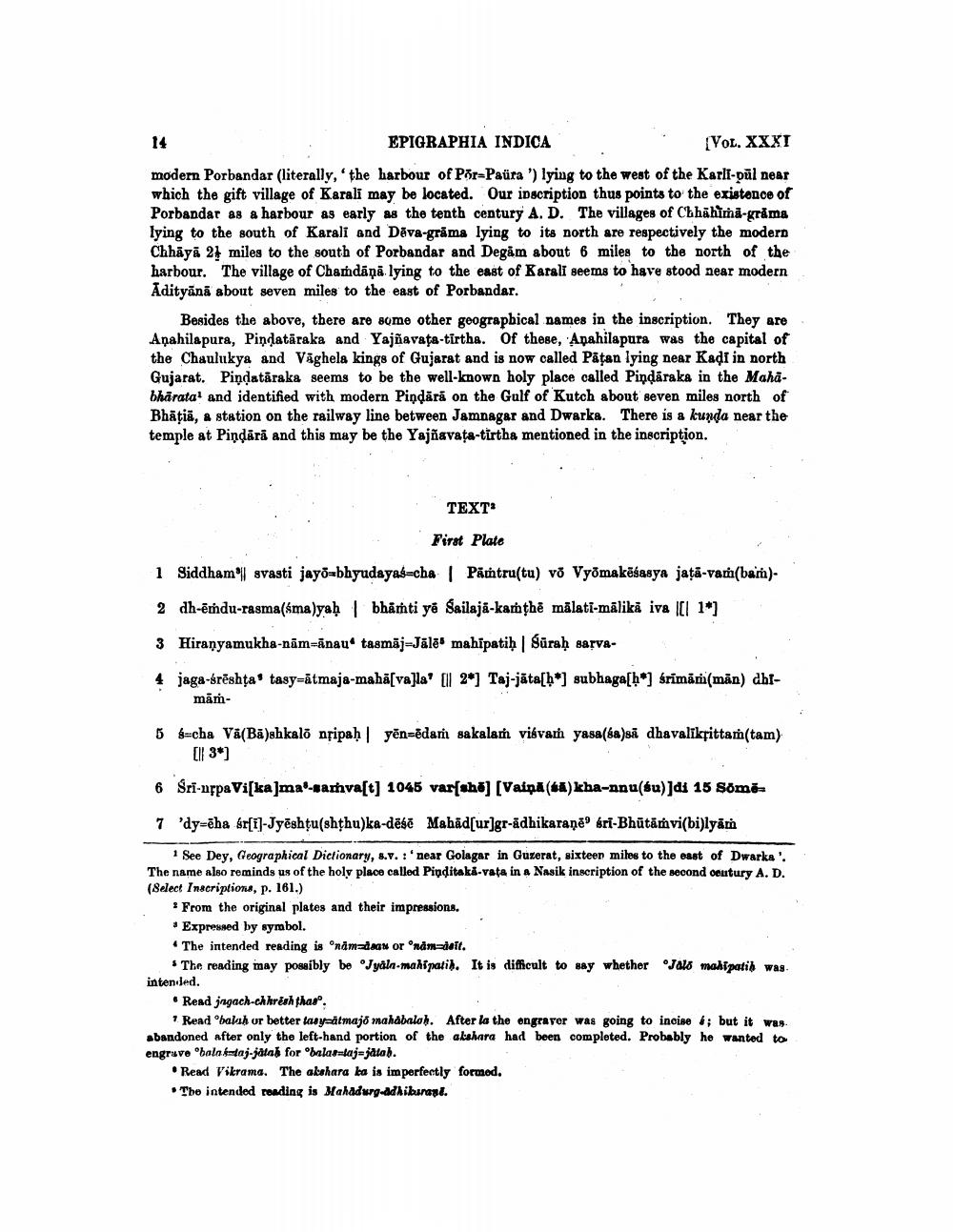________________
EPIGRAPHIA INDICA
(VOL. XXXI modern Porbandar (literally, the harbour of Põr=Paüra ') lying to the west of the Karli-pāl near which the gift village of Karali may be located. Our inscription thus points to the existence of Porbandar as a harbour as early as the tenth century A. D. The villages of Chhāhima-gråma lying to the south of Karali and Dāva-grāma lying to its north are respectively the modern Chhāyā 21 miles to the south of Porbandar and Degam about 6 miles to the north of the harbour. The village of Chandānā.lying to the east of Karali seems to have stood near modern Adityānā about seven miles to the east of Porbandar.
Besides the above, there are some other geographical names in the inscription. They are Anahilapura, Pindatäraka and Yajnavata-tirtha. Of these, Apahilapura was the capital of the Chaulukya and Vaghela kings of Gujarat and is now called Pätan lying near Kadi in north Gujarat. Pindatāraka seems to be the well-known holy place called Pindāraka in the Mahabharatat and identified with modern Pindārā on the Gulf of Kutch about seven miles north of Bhātiā, a station on the railway line between Jamnagar and Dwarka. There is a kunda near the temple at Piņdārā and this may be the Yajñavata-tirtha mentioned in the inscription.
TEXT
First Plate 1 Siddham|| svasti jayo=bhyudayas-cha | Pāntru(tu) võ Vyömakēšasya jatā-vari(ban)2 dh-ēmdu-rasmalkma)yaḥ | bhāti ye Sailajā-karathể mäleti-mālikā iva [I 1*) 3 Hiranyamukha-nām=ānau tasmāj=Jālet mahipatiḥ | Sūraḥ sarva4 jaga-śrēshta tasy=ātmaja-mahā[valla? [II 2*) Taj-jāta[b*) subhaga[b*) srimār(mān) dhi
mam
5 s=cha Vä(Bā)shkalo nsipah
[ll 3*]
yên=ēdar sakalan viévam yasa(sa)să dhavalikfittam(tam)
6 Sri-npa Vi[ka]ma'-samvast] 1045 var[sho] (Vaiņi(44) kha-nnu(su)]di 15 Somo 7 'dy- ha ár[i]-Jyēshtu(shthu)ka-dēsē Mahād[ur]gr-adhikaraņē' sri-Bhūtāmvi(bi)lyam
1 See Dey, Geographical Dictionary, s.v. :' near Golagar in Guzerat, sixteen miles to the east of Dwarka'. The name also reminds us of the holy place called Pipditaká-vata in a Nasik inscription of the second coutury A.D. (Select Inscriptions, p. 161.)
* From the original plates and their impressions. * Expressed by symbol. • The intended reading is onāmzdan ornam-doft.
The reading may possibly be "Jyala-mahipatih. It is difficult to say whether Jais makipatih was. intended.
• Read jngach-chherësh thaso.
* Read balah or better laayeitmajd mahabrloh. After la the engraver was going to incise &; but it was abandoned after only the left-hand portion of the akshara had been completed. Probably he wanted to engrave 'bola kdaj-játak for 'balas-taj-jatah.
Read Vikrama. The akshara ka is imperfectly formed, . The intended reading is Mahadurg-ddhiburapi.




